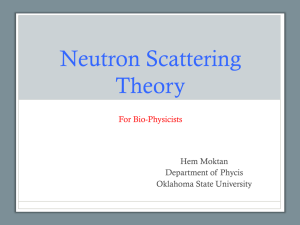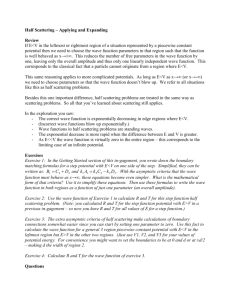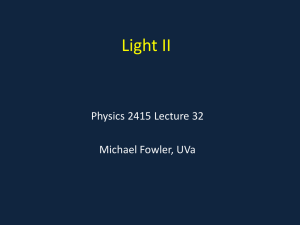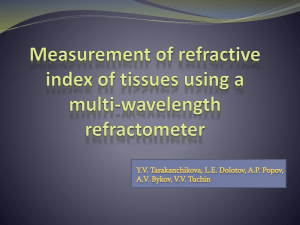Exam 4 Review Sheet - University of St. Thomas
advertisement
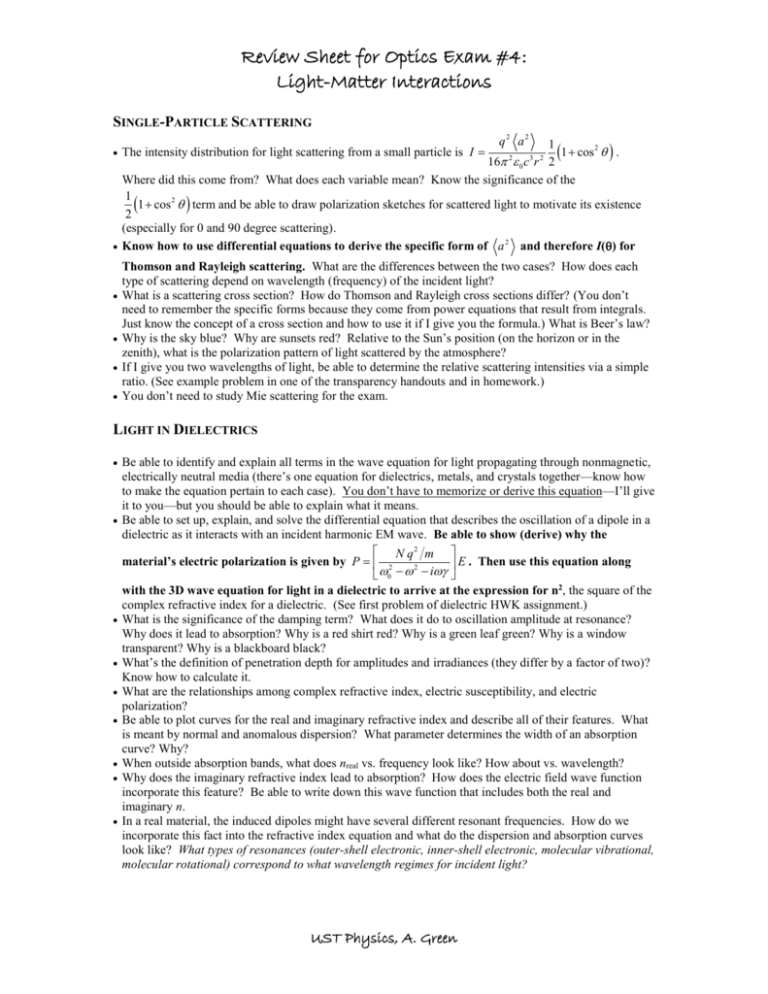
Review Sheet for Optics Exam #4: Light-Matter Interactions SINGLE-PARTICLE SCATTERING q2 a2 1 1 cos 2 . 16 0 c r 2 Where did this come from? What does each variable mean? Know the significance of the 1 1 cos2 term and be able to draw polarization sketches for scattered light to motivate its existence 2 (especially for 0 and 90 degree scattering). 2 Know how to use differential equations to derive the specific form of a and therefore I() for The intensity distribution for light scattering from a small particle is I 2 3 2 Thomson and Rayleigh scattering. What are the differences between the two cases? How does each type of scattering depend on wavelength (frequency) of the incident light? What is a scattering cross section? How do Thomson and Rayleigh cross sections differ? (You don’t need to remember the specific forms because they come from power equations that result from integrals. Just know the concept of a cross section and how to use it if I give you the formula.) What is Beer’s law? Why is the sky blue? Why are sunsets red? Relative to the Sun’s position (on the horizon or in the zenith), what is the polarization pattern of light scattered by the atmosphere? If I give you two wavelengths of light, be able to determine the relative scattering intensities via a simple ratio. (See example problem in one of the transparency handouts and in homework.) You don’t need to study Mie scattering for the exam. LIGHT IN DIELECTRICS Be able to identify and explain all terms in the wave equation for light propagating through nonmagnetic, electrically neutral media (there’s one equation for dielectrics, metals, and crystals together—know how to make the equation pertain to each case). You don’t have to memorize or derive this equation—I’ll give it to you—but you should be able to explain what it means. Be able to set up, explain, and solve the differential equation that describes the oscillation of a dipole in a dielectric as it interacts with an incident harmonic EM wave. Be able to show (derive) why the N q2 m material’s electric polarization is given by P 2 E . Then use this equation along 2 0 i with the 3D wave equation for light in a dielectric to arrive at the expression for n2, the square of the complex refractive index for a dielectric. (See first problem of dielectric HWK assignment.) What is the significance of the damping term? What does it do to oscillation amplitude at resonance? Why does it lead to absorption? Why is a red shirt red? Why is a green leaf green? Why is a window transparent? Why is a blackboard black? What’s the definition of penetration depth for amplitudes and irradiances (they differ by a factor of two)? Know how to calculate it. What are the relationships among complex refractive index, electric susceptibility, and electric polarization? Be able to plot curves for the real and imaginary refractive index and describe all of their features. What is meant by normal and anomalous dispersion? What parameter determines the width of an absorption curve? Why? When outside absorption bands, what does nreal vs. frequency look like? How about vs. wavelength? Why does the imaginary refractive index lead to absorption? How does the electric field wave function incorporate this feature? Be able to write down this wave function that includes both the real and imaginary n. In a real material, the induced dipoles might have several different resonant frequencies. How do we incorporate this fact into the refractive index equation and what do the dispersion and absorption curves look like? What types of resonances (outer-shell electronic, inner-shell electronic, molecular vibrational, molecular rotational) correspond to what wavelength regimes for incident light? UST Physics, A. Green Review Sheet for Optics Exam #4: Light-Matter Interactions LIGHT IN METALS Be able to write down and explain the F = ma differential equation that describes the oscillation of electrons in a metal as they interact with an incident harmonic EM wave. How does a metal’s differential equation differ from that for dielectrics? You don’t need to know how to do the full derivation for n2 of a metal starting from F = ma and the wave equation, BUT you should know how to obtain the expression for n2 for a metal starting with the n2 equation for a dielectric (it’s just a limiting case). Be able to plot general curves for the real and imaginary refractive index and describe their features in detail. What is the significance of the plasma frequency, and what is its relation to a metal’s refractive index and appearance (transparent vs. opaque, also colors)? How do the refractive index and the resulting wave function behave when the incident light’s frequency is much smaller than the collision frequency? When it is much greater than the collision frequency but larger than, smaller than, or nearly equal to the plasma frequency (know why n2 = 1 – (ωp/ω)2 in this case and how to look at different limits)? What about extreme cases of very large frequency? Explain in words and with diagrams. How do these different conditions affect the appearance of a piece of metal that you hold in your hand? (See Hecht section 4.8 and Fig. 4.59 for a good discussion of the appearance of metals. Also, see the metals summary sheets I gave you.) A generic electric field wave function inside of a metal is E E0 e i ( kz t ) . Explain and show mathematically how we modify the wave number k to reveal that the field decays with a particular penetration distance into the metal. (Rewrite the wave function.) Then show how this wave number is used to define the metal’s skin depth for irradiance (not simply E). Know how to convert between k of the light wave and n of the material. If I give you numbers for different types of frequencies, be sure you know what “regime” you’re dealing with (see previous two bullet points). LIGHT IN SEMICONDUCTORS In poorly conducting metals and in semiconductors, some electrons are free and others are loosely bound. How do we modify the expression for refractive index to account for both types of electrons? (Conversely, if you only know the equation for n2 of a semiconductor, you should be able to modify it to get n2 for either metals or dielectrics.) LIGHT IN CRYSTALS Just know the proof for why the Poynting vector isn’t necessarily parallel to the k-vector. Start with Gauss’s laws for E and B in a crystal and use the operator rules for derivatives. ExB is always parallel to S, but not necessarily k. Draw a sketch of these vectors along with wavefronts in the crystal. I will provide these equations, if necessary: J f 1 cos 2 2 E 2 P 1 2 E P 0 0 0 0 16 2 0 c 3 r 2 2 t 2 t t 2 0 Nq 2 1 2 n 1 E P 2 2 0 m 0 (0 i ) I q2 a2 A little over half of the exam will be derivations like we did in class because they tell a great story (the exam will probably lead you from start to finish through this story). The rest of the exam will be short calculations and conceptual questions. UST Physics, A. Green
